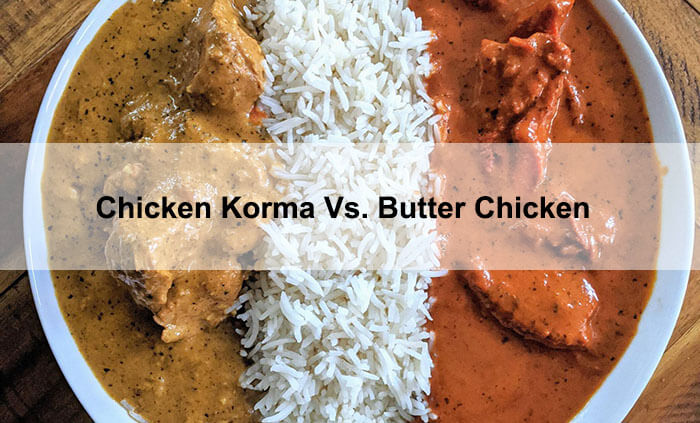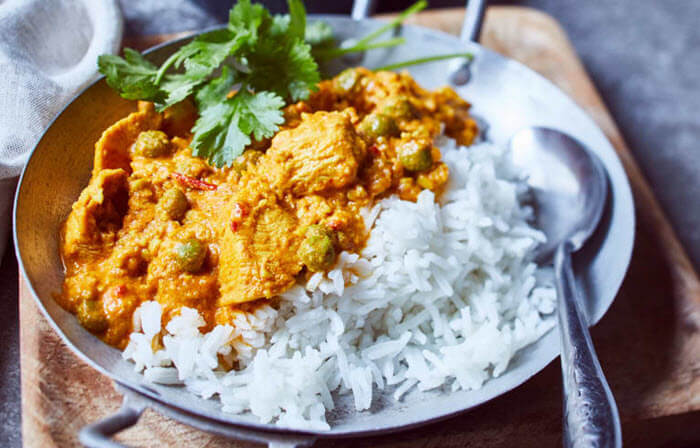Chicken korma and butter chicken (also known as “murgh makhani” and “chicken makhani”) are both bona fide staples of Indian cuisine.
The two dishes share many striking similarities in terms of taste, texture, and popular appeal. As similar as they may be, however, they’re not identical.
So, what’s the difference between chicken korma vs butter chicken?
Let’s take a closer look at this pair of Indian food favorites and find out just how alike they are.
Table Of Contents
What Is Chicken Korma?
Korma is a much-ordered entree that has its roots in the rich, exquisitely spiced feasts of the ancient Mughal empire. The dish derives its name from the Urdu word “qormā,” meaning “to braise.” This turn of phrase provides a critical clue as to how it’s made.
Korma is prepared by braising cuts of meat or hearty vegetables (or, in some cases, both) in a gravy consisting of thin yogurt, chicken stock or water, aromatic herbs, and freshly ground spices. The use of yogurt as opposed to heavy cream, which is more typical of Indian curries, gives korma a thicker, creamier consistency that’s offset by a just-right level of spice.
Chicken is probably the single most common protein choice for korma. That said, it’s not unusual for the dish to be served with lamb, goat, shrimp, paneer (Indian cottage cheese), or mixed veggies as an alternative or accompaniment.
Flavorful, filling, and exceedingly edible, chicken korma is about as solid a representative of Indian comfort food as you’re likely to find.
What Is Butter Chicken?
Hailing from northern India, murgh makhani, better known to Western diners as “butter chicken,” is a variety of curry that employs (you guessed it) butter as its chief flavoring.
Aside from its titular ingredients, this simple yet satisfying dish conventionally contains few other components: only stewed tomatoes or tomato paste, garlic, ginger, and assorted spices, in most incarnations.
If this particular formula sets some bells ringing, there’s a good reason—butter chicken originated as a chance riff [1] on tandoori chicken, and borrows heavily from tikka masala when it comes to basic composition and key tasting notes.
Butter chicken is a relatively recent addition to the Indian culinary canon, having only been around since the early 1950s. Still, its newness in comparison with older and better-known dishes hasn’t prevented it from becoming a smash hit and a permanent entry on the menus of Indian restaurants the world over.
Differences Between Chicken Korma vs Butter Chicken
Overlap is one thing, but the dishes we’ve been detailing here are anything but interchangeable. Here are a few of the noteworthy differences between butter chicken vs korma.
Chicken Korma | Butter Chicken | |
Flavor | Fairly light on spice | Tangier, smokier, and has a bit more bite |
Texture | Dense, heavy, and creamy | Smoother and slightly more oily |
Nutritional Value | 300 to 400 calories per serving | 500 to 700 calories per serving |
Price Point | Cheaper | More expensive |
Flavor
What does chicken korma taste like?
Korma is fairly light on spice, as far as curry-adjacent dishes go. Its main contributors are coriander, cumin, cardamom, and curry powder, all of which are used somewhat sparingly.
What does butter chicken taste like?
Butter chicken is without a doubt the bolder of the two, making use of all the standout seasonings mentioned above plus Kashmiri red chilis for a touch of heat. As such, it’s tangier, smokier, and has a bit more bite.
Furthermore, korma often makes use of mildly sweet additives like cashews and currants. Butter chicken does not, preferring to keep things straightforward by highlighting the complex spices intermingling in the curry itself.
Butter Chicken
Texture
Texture is another trait where korma and butter chicken diverge, for reasons that mostly have to do with their respective dairy bases.
Whereas the emphasis on yogurt makes korma dense, heavy, and creamy through and through, butter chicken generally has a consistency closer to those of traditional curries, only smoother and slightly more oily, thanks to the high fat content of the butter.
Nutritional Value
A typical serving of chicken korma might contain anywhere from 300 to 400 calories, depending on the precise proportions of yogurt and cream used. Butter chicken, on the other hand, can pack as many as 500-700 calories per serving, again thanks to all the fat in the butter.
It’s pretty close, but if you happen to be counting calories, korma will probably be the more responsible option.
Price Point
Menu prices can vary widely between eateries. As a general rule, though, you can expect to pay marginally more for butter chicken because it requires more ingredients, takes longer to make, and is easier to mess up.
By contrast, korma can be whipped up quite quickly with a minimum of costly ingredients.
Similarities Between Chicken Korma and Butter Chicken
Distinctive though they might be, chicken korma and butter chicken are not worlds apart. They have a surprising amount in common in all the ways that matter most to the majority of food lovers.
They Both Rely Heavily on Dairy
Since they have such a similar makeup, yogurt and butter impart remarkably similar flavor characteristics. Not only that, but both recipes call for copious quantities of cream, resulting in thick, hearty sauces that strike an optimal balance between sweet, spicy, and savory.
Chicken Korma
They’re Both Make for Tender, Juicy Chicken
Both of the cooking methods involved—korma is braised in a liquid mixture that’s predominantly yogurt and cream, while butter chicken is first slow-cooked and then simmered with its other constituent ingredients—serve to keep the chicken moist and ensure that every bite practically melts in your mouth.
They Both Feature Many of the Same Signature Spices
The spices in butter chicken may be more plentiful, but they’re not exclusive—many of them are the very same ones that give korma its quiet kick. Cooking either dish starts with measuring and mixing such ubiquitous seasonings as:
- Coriander
- Cloves
- Cardamom
- Cinnamon
- Black pepper
- Fenugreek
- Garam masala [2]
Conclusion
In the vast world of ethnic eats, Indian cuisine is unique in that many of its most iconic offerings are subtle variations on a central theme. There are arguably no two dishes that embody this concept better than chicken korma and butter chicken.
Regardless of which you ultimately go with, you can’t go wrong. Either way, you’re guaranteed a delightful meal, a full belly, and a desire to relive your enjoyment as soon as possible.
Related Posts:



